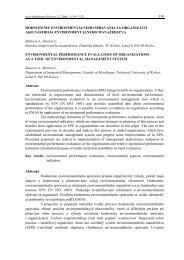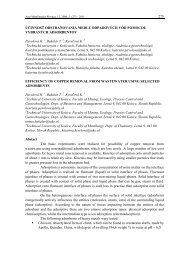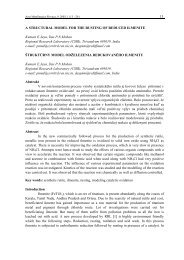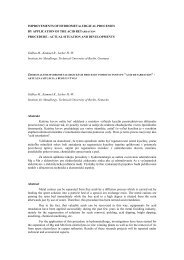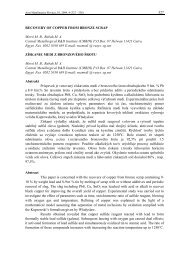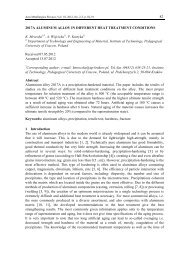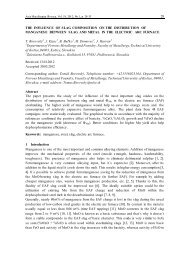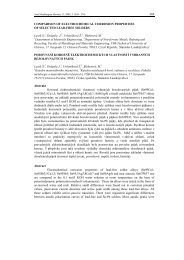MICROSTRUCTURAL FEATURES OF DC CAST A L/SIC MMC ...
MICROSTRUCTURAL FEATURES OF DC CAST A L/SIC MMC ...
MICROSTRUCTURAL FEATURES OF DC CAST A L/SIC MMC ...
You also want an ePaper? Increase the reach of your titles
YUMPU automatically turns print PDFs into web optimized ePapers that Google loves.
<strong>MICROSTRUCTURAL</strong> <strong>FEATURES</strong> <strong>OF</strong> <strong>DC</strong> <strong>CAST</strong> AL/<strong>SIC</strong> <strong>MMC</strong>SŠuštaršič B., Torkar M., Doberšek M., Breskvar B.Institute of Metals and Technology, Ljubljana, SloveniaMIKROŠTRUKTURÁLNE CHARAKTERISTIKY PRIAMO ODLIEVANÝCH AL/<strong>SIC</strong> KOMPOZITOV SKOVOVOU MATRICOUŠuštaršič B., Torkar M., Doberšek M., Breskvar B.Výskumný ústav kovov a technológie, Ljubljana, SlovinskoAbstraktKontinuálne a diskontinuálne spevnené Al/SiC kompozity s kovovou matricou (<strong>MMC</strong>s) súsľubné moderné a ľahké materiály s excelentnými vlastnosťami ako sú: vysoká tvrdosť a pevnosť priteplote okolia i pri zvýšených teplotách, dobrá odolnosť voči opotrebeniu a vysoký modul elasticity. Vsúčastnosti sa <strong>MMC</strong>s prevažne uplatňujú len vo vojenskom a vesmírnom priemysle. Avšak tietomateriály sa začínajú uplatňovať i v civilných aplikáciach.Medzi niekoľkými výrobnými procedúrami diskontinuálne spevnených Al/SiC <strong>MMC</strong>s, priamezačlenenie spevňovacej komponenty (SiC častice, doštičky alebo whiskre) do roztaveného hliníkapočas priameho vertikálneho kontinuálneho liatia čapov je najsľubnejšia a pravdepodobne ajnajlacnejšia priemyselná technológia výroby Al/SiC kompozitov. Táto procedúra je už rozvinutá dopriemyselnej škály, avšak tak použitie ako aj vlastnosti liatych kompozitov ktoré sú dôležité pre ichďalšie formovanie až do tvaru blízkemu konečnému tvaru stále vyžadujú ďalší výskum. Preto bolzakúpený a analyzovaný priamo kontinuálne liaty kompozit Duralcan F3S.20S (Al-9%Si zliatina s 20obj.% SiC častíc). V tomto članku sú prezentované a diskutované mikroštrukturálne a mechanickécharakteristiky tohto kompozitu.AbstractContinuously and discontinuously reinforced Al/SiC metal matrix composites (<strong>MMC</strong>s) arepromising modern, light weight materials with excellent properties, such as: high hardness and strengthat ambient and elevated temperatures, good wear resistance, and high modulus of elasticity. Currently,the use of <strong>MMC</strong>s is limited predominantly to the military and the aerospace industry. However, thepenetration of these materials has already begun also in civilian applications.Among several manufacturing procedures of discontinuously reinforced (DR) Al/SiC <strong>MMC</strong>s,a direct incorporation of the reinforcement (SiC particles, platelets or whiskers) into the molten Alalloy during direct vertical continuous (<strong>DC</strong>) casting of billets is the most promising and probably thecheapest industrial manufacture technology of Al/SiC composites. The procedure is already developedon the industrial scale; however, the use, as well as properties of cast composites important for furtherforming to near net shape products are still need to be investigated. Therefore, Duralcan's <strong>DC</strong> castcomposite F3S.20S (Al-9%Si alloy with 20 vol.% of SiC particles) was purchased and analyzed. In thisarticle, microstructural and mechanical characteristics of the cast composite are presented anddiscussed.
IntroductionCompared to conventional Al alloys, the Al alloy matrix based composites, reinforced withceramic particles have the best density-properties-price combination. Therefore, it is legitimate toexpect that these materials will substitute for part of conventional materials in mass production, forexample in automotive, as well as in other industries of transport vehicles. Today, these materials havealready begun to replace the conventional materials in computers, audio and video equipment, as wellas in equipment for sports and leisure [1-4].There are several ways of DR Al/SiC manufacture: direct incorporation of relatively roughSiC particles into the molten Al alloy, infiltration of porous SiC preforms with the molten Al alloy orvia powder metallurgy (PM) procedures [1,2,5]. Generally, Al/SiC composites manufactured by PMhave the best mechanical properties because they contain in the Al alloy matrix finer and moreuniformly distributed reinforcement (SiC particles or whiskers) [6,7]. These composites also havebetter chemical and microstructural homogeneity, but are very expensive because of the complexity ofthe manufacturing.The basic purpose of adding reinforcement into the metal matrix is to increase the yieldstrength. Tensile strength and hardness at ambient, as well as at elevated temperatures are alsoincreased. The result is improved wear resistance of the material. With increased SiC addition, themodule of elasticity increases linearly and thermal expansion decreases. Unfortunately, with increasedcontent of reinforcement the ductility of the composite is drastically decreased. Tensile andcompression ductility of Al/SiC <strong>MMC</strong>s are very different. These composites resist compressionloading very well, but they are very sensitive to tensile load. Therefore, these materials are appropriatefor hot forming in closed dies (die forging, hot pressing, extrusion etc.). Experimental investigations[8] show also that these materials can be successfully cold formed into near net shaped products ifproper heat treatment of the metal matrix is performed. Specific studies [9,10] show that increasedhot/cold working of the composite increases tensile ductility and fracture toughness for a given state ofthe metal matrix. These improvements are attributed to the more uniform distribution of local stressesand larger distances between crack initiation sites. Numerous investigations [10-12] show thatincreased hot/cold deformation increases damages of reinforcement and decreases the mean SiCparticle size or the length/diameter ratio of SiC whiskers, respectively. Considerable efforts have alsobeen made to accommodate chemical composition of the metal matrix in order to increase/optimizedeformability of these materials.The production of DR Al/SiC composites by incorporation of up to 25 vol.% of SiC particlesinto a molten Al alloy during direct vertical continuous (<strong>DC</strong>) casting of billets is already developed onthe industrial scale [13-15]. In this way (see Figure 1), produced blocks or billets of composites arecheaper than the composites manufactured by the PM route. First of all, these cast composites areappropriate for further forming of near net shaped products with pressure die or sand casting [13-17]because the key problem of these materials is its poor machinability [18-21]. Successful machining isonly possible with PCD (Poly-Crystalline Diamond) tools and recently also with CVD <strong>DC</strong>C (ChemicalVapour Deposited Diamond Coated Carbide) inserts, and at appropriate machining rates.Fig.1 Schematic presentation of Al/SiC <strong>MMC</strong>s manufacture by incorporation of SiC particlesduring direct vertical continuous casting [15]Considering that it is not realistic to expect essential improvement of composite machinability,the only reasonable way of composite product manufacture is developing technologies that make itpossible to manufacture products requiring minimal mechanical treatment. The prevailing technologyis casting (the above mentioned <strong>DC</strong> casting followed by pressure die casting or infiltration of porousceramic preforms). However, the procedures of hot/cold forming would also be worth considering, buthaving regards that composites with the metal matrix (besides Al- also Mg- or Ti-alloys) can contain10-50 vol.% of very hard (3000 HV) and abrasive particles or whiskers (not only SiC or Al 2 O 3 , butalso AlN, TiB 2 etc.).The most frequently selected matrix materials, reinforced with alumina (Al 2 O 3 ) or SiC arewrought alloys type 2014 or 6061 and casting Al-Si alloys (silumins with approximately 7-12 % of Si)[22]. For our investigations and experiments, Duralcan´s composite F3S.20S (359/SiC/20p accordingto Aluminium Association <strong>MMC</strong>s) was selected. According to the manufacturer, this material is
appropriate for sand and pressure die casting. Furthermore, some hot working experiments (dieforging) and investigations have already been made [23] with this material for the production of brakediscs.In Table 1 nominal and actual (determined at IMT, Ljubljana) chemical compositions of themetal matrix are given. The selected composite in this metal matrix contains (according to themanufacturer`s specification) approximately 20 vol.% of SiC particles with the mean diameter (d 50 ) of≈13 µm. For comparison, in Table 1 the chemical composition of the F3K matrix is given. Thismaterial is recommended for high-temperature applications and therefore contains a higher content ofalloying elements (Cu, Ni and Mg).Table 1 Metal matrix chemical compositions of Duralcan´s Al/SiC <strong>MMC</strong>s, types F3S and F3K* Al in matrix and 20-23 vol.% of SiC particles as reinforcementA Slovenian manufacturer of wrought and cast Al products expressed interest in thepossibility of developing an extrusion technology of <strong>MMC</strong>s. Therefore, in the first stage of our project(supported also by the Slovenian Ministry of Science and Technology), mechanical and microstructuralcharacterization of the selected composite was made. The results of our investigations are given below.Experimental workProper microstructural and mechanical characterization of the selected material is necessaryfor successful laboratory and industrial hot extrusion experiments. Therefore, from <strong>DC</strong> cast billets ofcomposite (Φ178 × 1000 mm) we cut off samples, parallel and perpendicular to the cast direction ofbillets. Slow and relatively expensive, high water pressure (3000 bars) jet equipment was used forcutting off samples from relatively large <strong>DC</strong> cast billets. Afterwards, standard test specimens formetallographic and mechanical investigations were machined from samples. Some problems occurredduring the machining of specimens, because only standard tungsten carbide tools were used. Thepreparation of test specimens is complex because of the nature of this type of composite materials (veryhard particles in soft matrix). For the preparation of metallographic samples, it was necessary to selectproper cutting, grinding and polishing materials, as well as to develop proper procedures.In order to estimate the pressure necessary for the hot extrusion of billets, the true stress (k f inMPa) of composite under compression in the expected extrusion temperature region (420-470°C ) andat different deformation rates (dε/dt=0.1-3 s -1 ) was determined. The true stress of the composite undercompression loading of cylindrical specimens (Figure 2) was determined with Gleeble 1500 (DuffersScientific Inc.) apparatus.Results and discussionBrinell hardness and tensile properties of <strong>DC</strong> cast billets were determined on standard testspecimens (DIN 50351, 50125 and 50145). Room temperature hardness HB 2,5/187,5 =105-110 isexpected. Average tensile strength in perpendicular direction (Rm ≈260 MPa) does not differ
Detailed quantitative image analysis showed that the average equivalent spherical diameter ofSiC particles is 7,6 µm, its form factor/index (roundness) is 0,75 and its content in the metal matrix is23 %. Figures 6 and 7 show a sample of particle size and roundness distribution results determined bythe quantitative image analysis.SiC particles are located in eutectic fields (Figure 5), pushed away from the α Al grains ofsolid solution due to the fact that eutectic solidifies last (at ≈577°C). In accordance with the smalldifference in mechanical properties between parallel and perpendicular direction of casting, largermicrostructural differences are not observed. The observation of polished samples with opticalmicroscope showed that porosity of billets is negligible. On the basis of microstructural investigationsand comparing the outer layer and the core of the billet it can be concluded that during solidification ofbillets, growth of α Al grains was hindered. This results from the facts that in the core (reinforced withSiC) of the billet, primary dendrites of α Al are smaller and more globular than in the outer (with SiCpoorer or unreinforced) region. In contrast with the billet core, the outer layer has well defined dendritemorphology of solidification.In literature [24-28], there is little data about deformability of Al/SiC <strong>MMC</strong>s at elevatedtemperatures. It can be concluded that Al/SiC <strong>MMC</strong>s can be extruded at similar conditions as wroughtAl alloys without reinforcement. Extrusion velocities are practically the same, working pressures are10-20% higher and extrusion can be performed successfully at extrusion ratios from 16:1 up to 45:1.For the investigated material, the extrudability was unknown to us. Therefore, the above mentionedtrue stresses were determined. Figures 8 a and b show true stresses of the investigated material in thetemperature range commonly applied for the extrusion of Al alloys, as well as at expected deformationrates.On the basis of theoretical and semi-empirical equations [29], the determined true stresses ofthe investigated material made it possible to estimate the working pressure of the extrusion and thecapacity of the extrusion press for the selected billet dimensions, respectively. It was established thatthe 20 MN industrial press (Schlömann, Germany), located at the Slovenian factory Impol would beappropriate for our experimental work. The biggest problem of the extrusion of Al/SiC <strong>MMC</strong>s is theiralready mentioned poor machinability. This leads to difficulties during billets/extruded profiles cuttingand causes excessive wear of extrusion die. Therefore, conventional cutting and tool steel areunsuitable. As a die material, it is recommended [24] to use tungsten carbide or PM tool steel, PVD orCVD coated with a tin layer of TiN/TiC and in addition, special die lubricants have to be used. Incomparison with conventional unreinforced materials, thermal conductivity of Al/SiC <strong>MMC</strong>s is lowerand heat capacity is higher. Therefore, one can expect longer duration of billet heating on the extrusiontemperature and more intensive heating of extrusions during the deformation.ConclusionsThe results of our microstructural and mechanical investigations show that it is alreadypossible to manufacture, on the industrial scale, <strong>DC</strong> cast Al/SiC <strong>MMC</strong>s of good quality. Therefore, inthe near future, these materials may become a serious rival to conventional Al alloys. Theseinvestigations also allow us to carry out extrusion experiments and further improvement of mechanicalproperties by additional hot deformation of <strong>DC</strong> cast Al/SiC <strong>MMC</strong>s and its proper further heattreatment.Literature[1] B. Terry, G. Jones: Metal Matrix Composites, Elsevier Advanced Technology, Elsevier SciencePublishers Ltd., Oxford, UK, 1990[2] K.U. Kainer: Metalische Verbundwerkstoffe, DGM-Informationsgesselschaft Verlag, Ober-ursel,Germany, 1994
[3] S. Pickering: Bicycle industry takes <strong>MMC</strong> for a ride, Metal Powder Report, 50, June 1995, 6, 30-33[4] METALBA S.p.A.: The use of composites in sports articles, commercial catalogue Metalba S.p.A.,Bassano del Grappa, Italy, 1996[5] F. L. Matthews, R. D. Rawlings: Composite Materials: Engineering and Science, Chapman & Hall,London, UK, 1994[6] R.J. Arsenault, S.B. Wu: A comparison of PM versus melted Al/SiC composites, ScriptaMetallurgica, 22, 1988, 767-772[7] B.L. Mordike, K.U. Kainer, J. Schroeder: Powder metallurgical preparation of composite materials,Transaction of the PMAl, 17, 1990, 7-17[8] J. Jiang et al.: Room temperature formability of particle-reinforced metal matrix composites:forging, extrusion and deep drawing, Composites, 26, 1995, 11, 785-789[9] F. Simančik, G. Jangg: Influence of processing parameters on fibre damage and mechanicalproperties of extruded composite with aluminium matrix and short carbon fibres, Theoretical andApplied Fracture Mechanics, 20, 1994, 11-20[10] F.J. Humphreys: The thermomechanical processing of Al-SiC particulate composites, MaterialScience and Engineering, A135, 1991, 267-273[11] W. Wang, Z. Zhang, Y. Chen, X. Li: SiC particle reinforced aluminium composites, Institute ofComposite Materials Reports, Shanghai Jiao Tong University, China, 203-207[12] J.D. Embury, S.Tao, J. Newall, F. Zok: Damage accumulation in metal-matrix composites and itsrole in hydrostatic extrusion, Mc Master University Hamilton, Ontario, Canada, 187-193[13] D. O. Kennedy: SiC Particles Beef Up Investment-Cast Aluminium, Advanced Materials &Processes, 6/91, 42-46.[14] W.R. Hoover: Die casting of Duralcan composites, Duralcan's reports, 1991, 387-392[15] F. Adam, C. Vives: Die-casting under low pressure of electromagnetically elaborated semi-solidmetal matrix composites, Proceedings of the 5-th European Conference on Advanced Materialsand Processes and Applications, Euromat 97, Maastricht, Nizozemska, 1, 1997, 337-340[16] P.M.N. Ocansey et al.: Solidification, thermal analysis and properties of SiC particle reinforcedAl 11.7 alloy composites, Giessereiforschung, 48, 1996, 3, 82-83[17] P. Zenisek et al.: Structure and mechanical properties of Al-SiC metal matrix composite withadditions of SiC particles, Metallurgical Science and Technology, 14, 1996, 1, 37-44[18] H.S. Oberoi: Machining of metal matrix composites with diamond tools, Cutting Tool News, June1996, 8-10[19] C.T. Lane: Machining characteristics of particle-reinforced aluminium, Duralcan's reports, 1996,195-201[20] D. Biermann: Mechanishe Bearbeitung von Leichtmetall-Verbundwerkstoffen, Institut fürSpanende Fertigung Berichte, University of Dortmund, Germany, 1996, 1-26[21] A.R. Chambers: The machinability of light alloy <strong>MMC</strong>s, Composites, Part A, 27A, 1996, 2, 143-147[22] E.A. Brandes, G. B. Brook: Smithells Metals Reference Book, 7-th edition, ButterworthHeinemann, Oxford, UK, 1992[23] A.M. De Sanctis, E. Evangelista, A. Forcellese, A. Fuganti: Forging of <strong>MMC</strong> for an automotivecomponent, Metallurgical Science and Technology, 14, 1996, 1, 13-19[24] V.B. Dickson: Further developments in the extrusion of aluminium based metal matrixcomposites, Extrusion Technology '96, Chicago, USA, May 1996, 1-31[25] P.W. Jeffrey, S. Holcomb: Extrusion of particulate-reinforced aluminium matrix composites,Duralcan reports, 181-186
[26] S. Brusethaug, O. Reiso, W. Ruch: Extrusion of particulate-reinforced aluminium billets made byd.c. casting, Hydro Aluminium reports, 173-179[27] H.P. Degischer, H. Kaufmann, H. Leitner: Strangpreprofile, Schmiede- und Guteile auskeramikteilchenverstärktem Aluminium, VDI Berichte, No.: 965.1, 1992, 179-188[28] D.J. Jensen, Y.L. Liu, N. Hansen: Hot extrusion of Al/SiC texture and microstructure, Proceedingsof the 12-th Riso International Symposium on Material Science Roskilde, Denmark, 1991, 417-422[29] K. Laue, H. Stenger: Extrusion; Processes, Machinery, Tooling, American Society for Metals,Metals Park, Ohio, USA, 1981



